Regulation of Blood Sugar and Temperature
VerifiedAdded on 2020/10/05
|21
|4083
|90
AI Summary
This assignment discusses the regulation of blood sugar levels through the interaction of insulin and glucagon, and how temperature is controlled through homeostatic mechanisms. The endocrine system's role in regulating various bodily functions is also explored. References to various articles, patents, and online resources are included, providing a comprehensive overview of these complex systems.
Contribute Materials
Your contribution can guide someone’s learning journey. Share your
documents today.

Homeostasis (Biology)
Secure Best Marks with AI Grader
Need help grading? Try our AI Grader for instant feedback on your assignments.
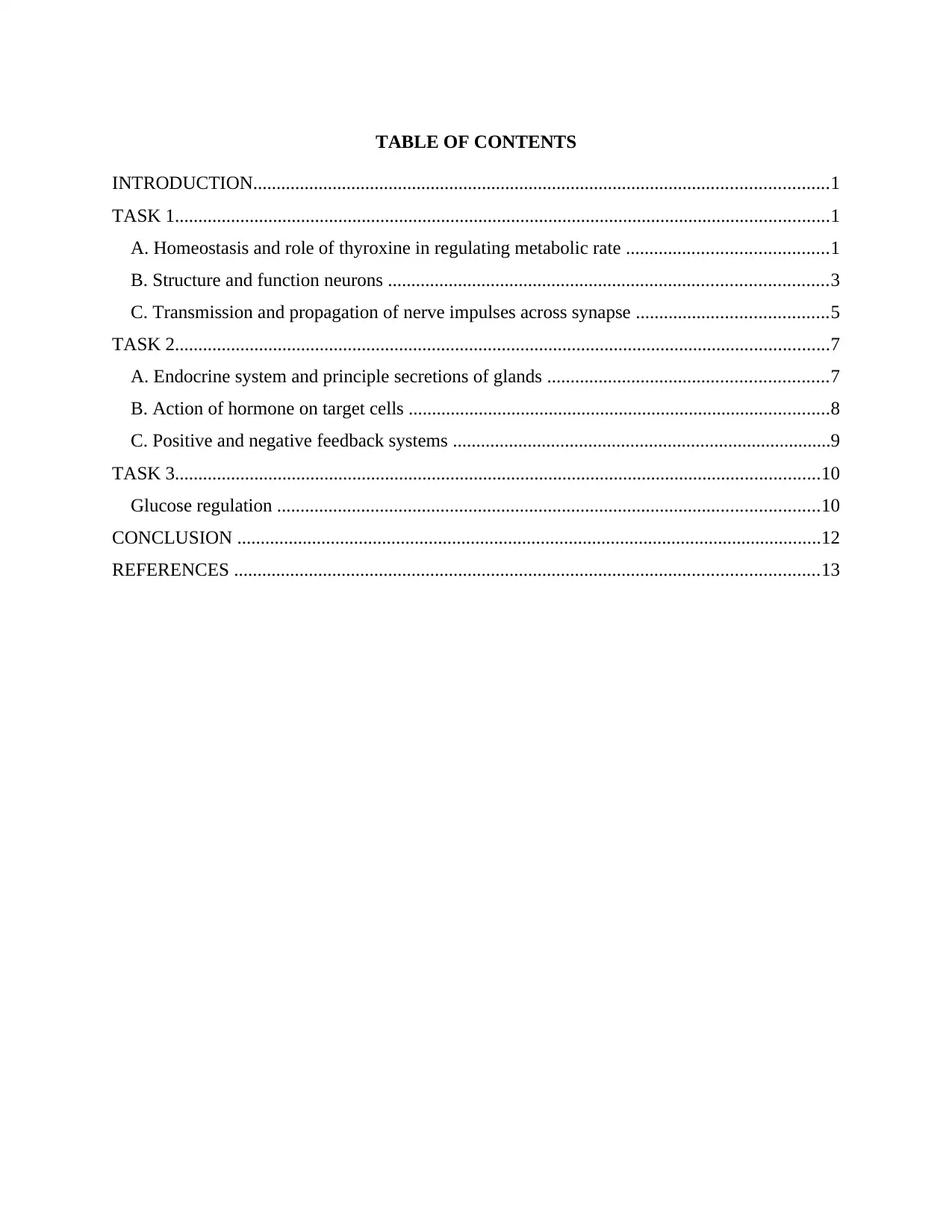
TABLE OF CONTENTS
INTRODUCTION...........................................................................................................................1
TASK 1............................................................................................................................................1
A. Homeostasis and role of thyroxine in regulating metabolic rate ...........................................1
B. Structure and function neurons ..............................................................................................3
C. Transmission and propagation of nerve impulses across synapse .........................................5
TASK 2............................................................................................................................................7
A. Endocrine system and principle secretions of glands ............................................................7
B. Action of hormone on target cells ..........................................................................................8
C. Positive and negative feedback systems .................................................................................9
TASK 3..........................................................................................................................................10
Glucose regulation ....................................................................................................................10
CONCLUSION .............................................................................................................................12
REFERENCES .............................................................................................................................13
INTRODUCTION...........................................................................................................................1
TASK 1............................................................................................................................................1
A. Homeostasis and role of thyroxine in regulating metabolic rate ...........................................1
B. Structure and function neurons ..............................................................................................3
C. Transmission and propagation of nerve impulses across synapse .........................................5
TASK 2............................................................................................................................................7
A. Endocrine system and principle secretions of glands ............................................................7
B. Action of hormone on target cells ..........................................................................................8
C. Positive and negative feedback systems .................................................................................9
TASK 3..........................................................................................................................................10
Glucose regulation ....................................................................................................................10
CONCLUSION .............................................................................................................................12
REFERENCES .............................................................................................................................13
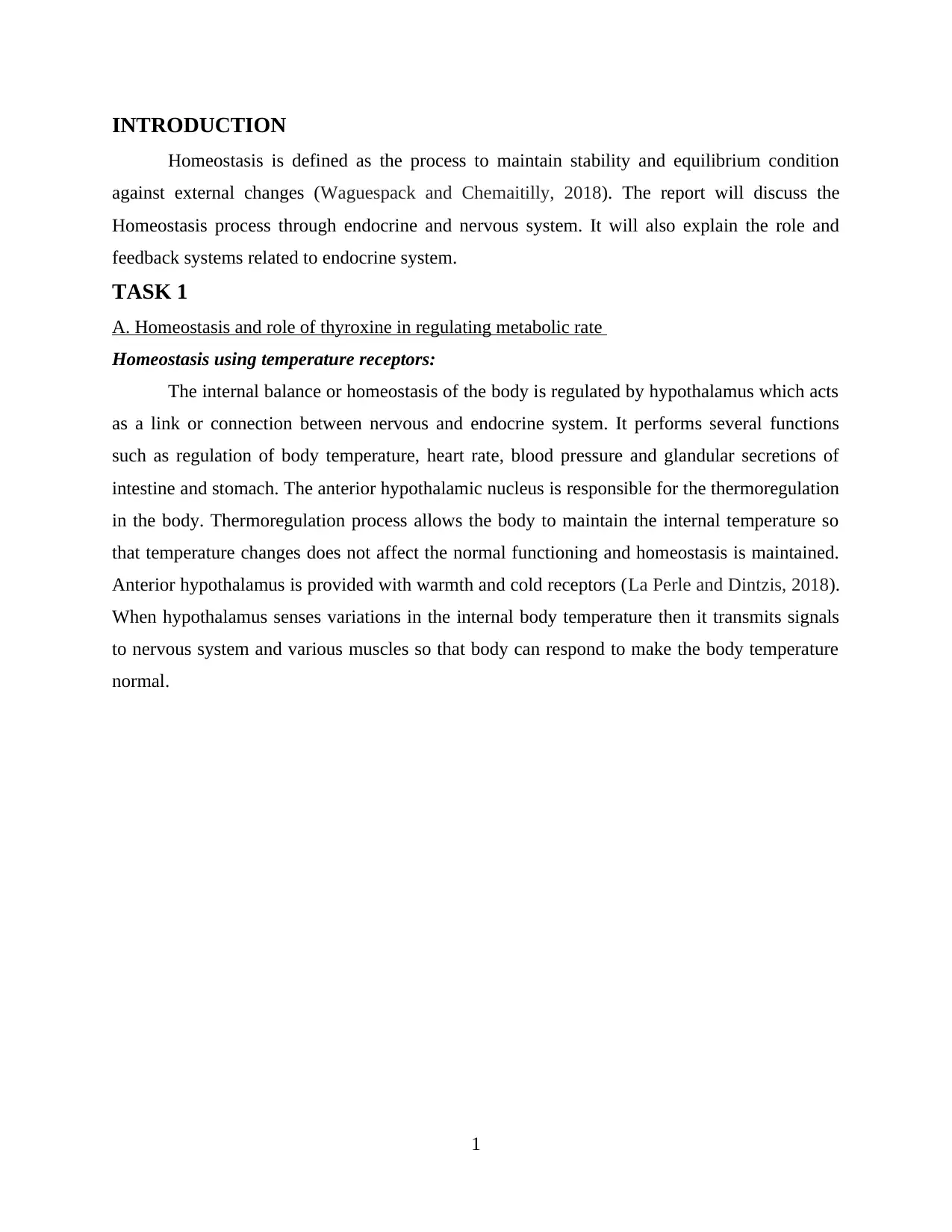
INTRODUCTION
Homeostasis is defined as the process to maintain stability and equilibrium condition
against external changes (Waguespack and Chemaitilly, 2018). The report will discuss the
Homeostasis process through endocrine and nervous system. It will also explain the role and
feedback systems related to endocrine system.
TASK 1
A. Homeostasis and role of thyroxine in regulating metabolic rate
Homeostasis using temperature receptors:
The internal balance or homeostasis of the body is regulated by hypothalamus which acts
as a link or connection between nervous and endocrine system. It performs several functions
such as regulation of body temperature, heart rate, blood pressure and glandular secretions of
intestine and stomach. The anterior hypothalamic nucleus is responsible for the thermoregulation
in the body. Thermoregulation process allows the body to maintain the internal temperature so
that temperature changes does not affect the normal functioning and homeostasis is maintained.
Anterior hypothalamus is provided with warmth and cold receptors (La Perle and Dintzis, 2018).
When hypothalamus senses variations in the internal body temperature then it transmits signals
to nervous system and various muscles so that body can respond to make the body temperature
normal.
1
Homeostasis is defined as the process to maintain stability and equilibrium condition
against external changes (Waguespack and Chemaitilly, 2018). The report will discuss the
Homeostasis process through endocrine and nervous system. It will also explain the role and
feedback systems related to endocrine system.
TASK 1
A. Homeostasis and role of thyroxine in regulating metabolic rate
Homeostasis using temperature receptors:
The internal balance or homeostasis of the body is regulated by hypothalamus which acts
as a link or connection between nervous and endocrine system. It performs several functions
such as regulation of body temperature, heart rate, blood pressure and glandular secretions of
intestine and stomach. The anterior hypothalamic nucleus is responsible for the thermoregulation
in the body. Thermoregulation process allows the body to maintain the internal temperature so
that temperature changes does not affect the normal functioning and homeostasis is maintained.
Anterior hypothalamus is provided with warmth and cold receptors (La Perle and Dintzis, 2018).
When hypothalamus senses variations in the internal body temperature then it transmits signals
to nervous system and various muscles so that body can respond to make the body temperature
normal.
1
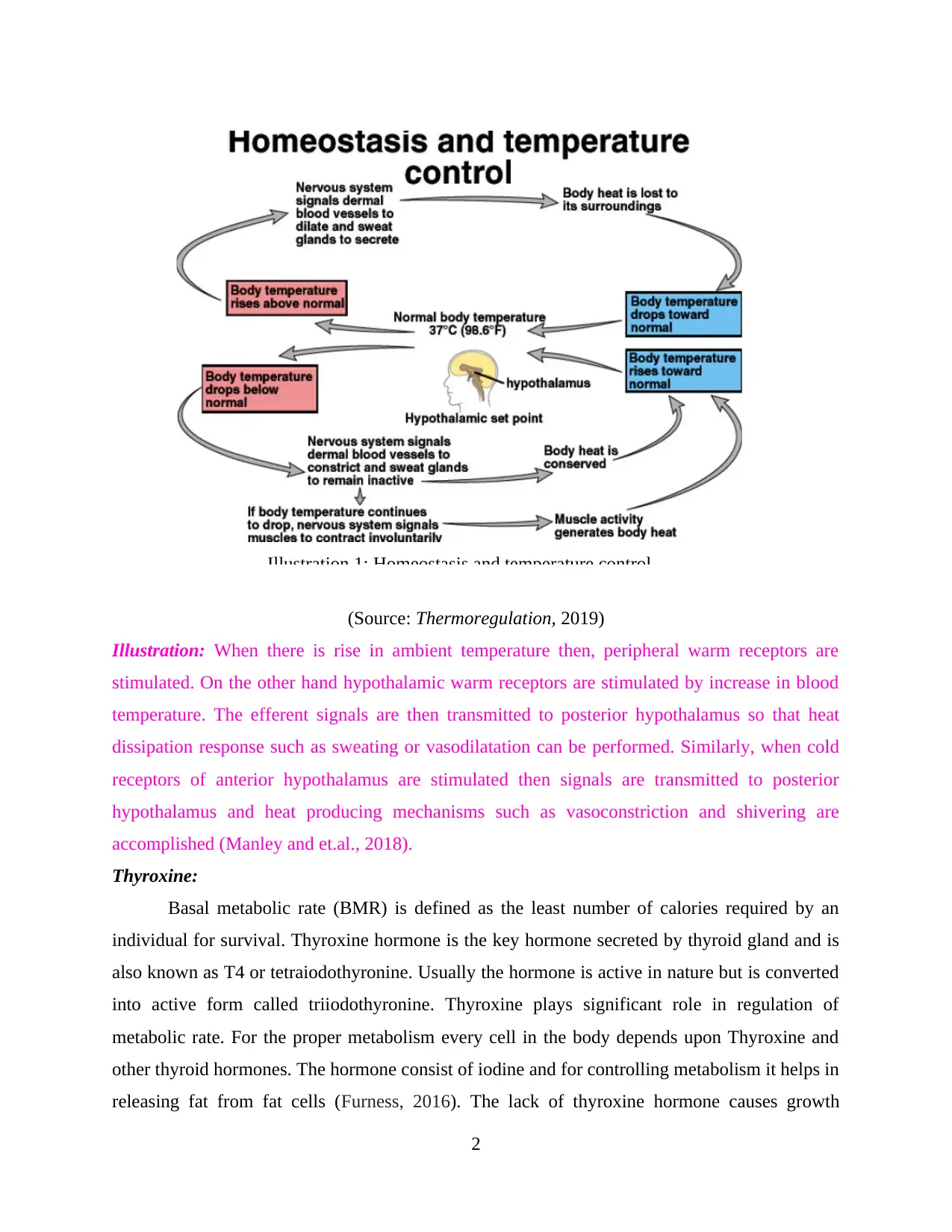
(Source: Thermoregulation, 2019)
Illustration: When there is rise in ambient temperature then, peripheral warm receptors are
stimulated. On the other hand hypothalamic warm receptors are stimulated by increase in blood
temperature. The efferent signals are then transmitted to posterior hypothalamus so that heat
dissipation response such as sweating or vasodilatation can be performed. Similarly, when cold
receptors of anterior hypothalamus are stimulated then signals are transmitted to posterior
hypothalamus and heat producing mechanisms such as vasoconstriction and shivering are
accomplished (Manley and et.al., 2018).
Thyroxine:
Basal metabolic rate (BMR) is defined as the least number of calories required by an
individual for survival. Thyroxine hormone is the key hormone secreted by thyroid gland and is
also known as T4 or tetraiodothyronine. Usually the hormone is active in nature but is converted
into active form called triiodothyronine. Thyroxine plays significant role in regulation of
metabolic rate. For the proper metabolism every cell in the body depends upon Thyroxine and
other thyroid hormones. The hormone consist of iodine and for controlling metabolism it helps in
releasing fat from fat cells (Furness, 2016). The lack of thyroxine hormone causes growth
2
Illustration 1: Homeostasis and temperature control
Illustration: When there is rise in ambient temperature then, peripheral warm receptors are
stimulated. On the other hand hypothalamic warm receptors are stimulated by increase in blood
temperature. The efferent signals are then transmitted to posterior hypothalamus so that heat
dissipation response such as sweating or vasodilatation can be performed. Similarly, when cold
receptors of anterior hypothalamus are stimulated then signals are transmitted to posterior
hypothalamus and heat producing mechanisms such as vasoconstriction and shivering are
accomplished (Manley and et.al., 2018).
Thyroxine:
Basal metabolic rate (BMR) is defined as the least number of calories required by an
individual for survival. Thyroxine hormone is the key hormone secreted by thyroid gland and is
also known as T4 or tetraiodothyronine. Usually the hormone is active in nature but is converted
into active form called triiodothyronine. Thyroxine plays significant role in regulation of
metabolic rate. For the proper metabolism every cell in the body depends upon Thyroxine and
other thyroid hormones. The hormone consist of iodine and for controlling metabolism it helps in
releasing fat from fat cells (Furness, 2016). The lack of thyroxine hormone causes growth
2
Illustration 1: Homeostasis and temperature control
Secure Best Marks with AI Grader
Need help grading? Try our AI Grader for instant feedback on your assignments.
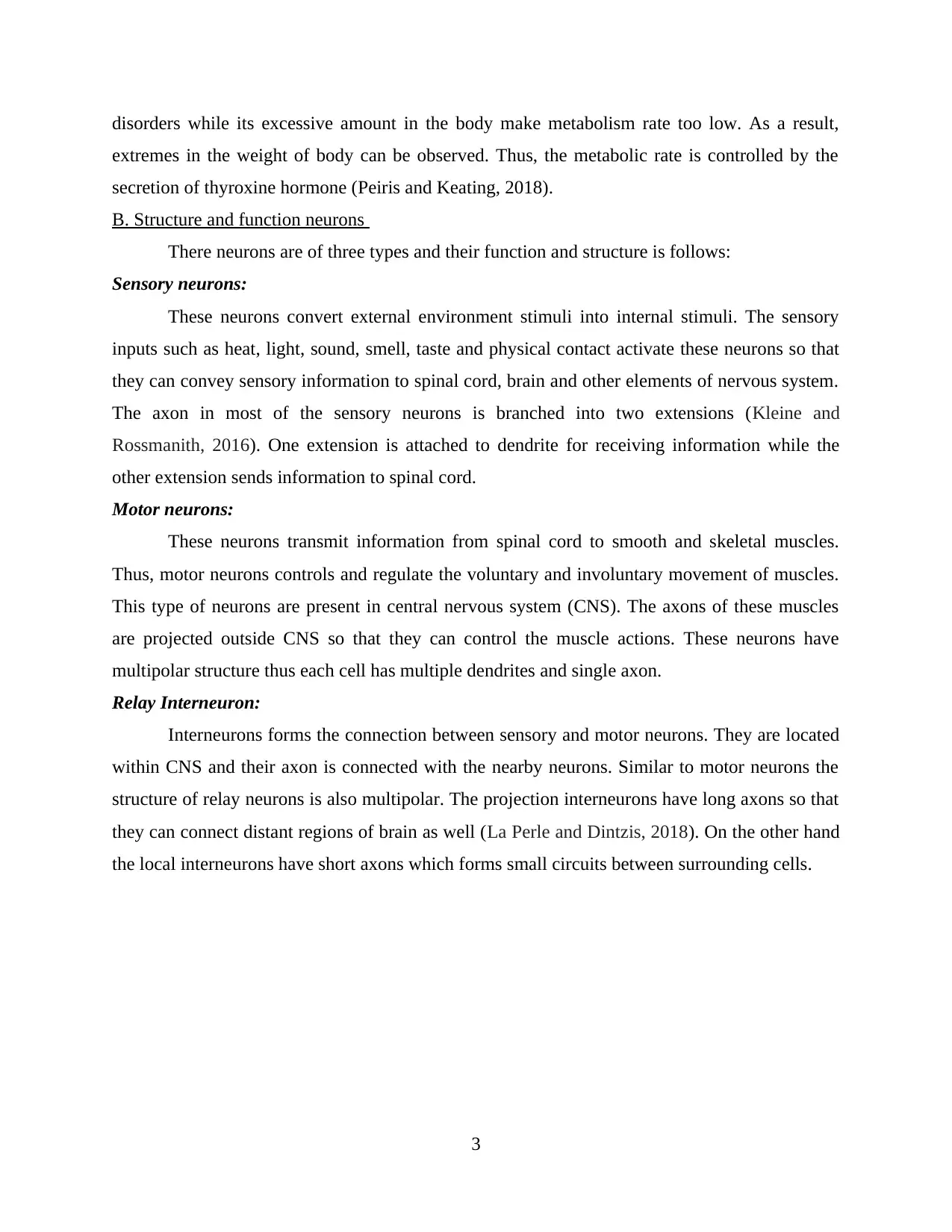
disorders while its excessive amount in the body make metabolism rate too low. As a result,
extremes in the weight of body can be observed. Thus, the metabolic rate is controlled by the
secretion of thyroxine hormone (Peiris and Keating, 2018).
B. Structure and function neurons
There neurons are of three types and their function and structure is follows:
Sensory neurons:
These neurons convert external environment stimuli into internal stimuli. The sensory
inputs such as heat, light, sound, smell, taste and physical contact activate these neurons so that
they can convey sensory information to spinal cord, brain and other elements of nervous system.
The axon in most of the sensory neurons is branched into two extensions (Kleine and
Rossmanith, 2016). One extension is attached to dendrite for receiving information while the
other extension sends information to spinal cord.
Motor neurons:
These neurons transmit information from spinal cord to smooth and skeletal muscles.
Thus, motor neurons controls and regulate the voluntary and involuntary movement of muscles.
This type of neurons are present in central nervous system (CNS). The axons of these muscles
are projected outside CNS so that they can control the muscle actions. These neurons have
multipolar structure thus each cell has multiple dendrites and single axon.
Relay Interneuron:
Interneurons forms the connection between sensory and motor neurons. They are located
within CNS and their axon is connected with the nearby neurons. Similar to motor neurons the
structure of relay neurons is also multipolar. The projection interneurons have long axons so that
they can connect distant regions of brain as well (La Perle and Dintzis, 2018). On the other hand
the local interneurons have short axons which forms small circuits between surrounding cells.
3
extremes in the weight of body can be observed. Thus, the metabolic rate is controlled by the
secretion of thyroxine hormone (Peiris and Keating, 2018).
B. Structure and function neurons
There neurons are of three types and their function and structure is follows:
Sensory neurons:
These neurons convert external environment stimuli into internal stimuli. The sensory
inputs such as heat, light, sound, smell, taste and physical contact activate these neurons so that
they can convey sensory information to spinal cord, brain and other elements of nervous system.
The axon in most of the sensory neurons is branched into two extensions (Kleine and
Rossmanith, 2016). One extension is attached to dendrite for receiving information while the
other extension sends information to spinal cord.
Motor neurons:
These neurons transmit information from spinal cord to smooth and skeletal muscles.
Thus, motor neurons controls and regulate the voluntary and involuntary movement of muscles.
This type of neurons are present in central nervous system (CNS). The axons of these muscles
are projected outside CNS so that they can control the muscle actions. These neurons have
multipolar structure thus each cell has multiple dendrites and single axon.
Relay Interneuron:
Interneurons forms the connection between sensory and motor neurons. They are located
within CNS and their axon is connected with the nearby neurons. Similar to motor neurons the
structure of relay neurons is also multipolar. The projection interneurons have long axons so that
they can connect distant regions of brain as well (La Perle and Dintzis, 2018). On the other hand
the local interneurons have short axons which forms small circuits between surrounding cells.
3
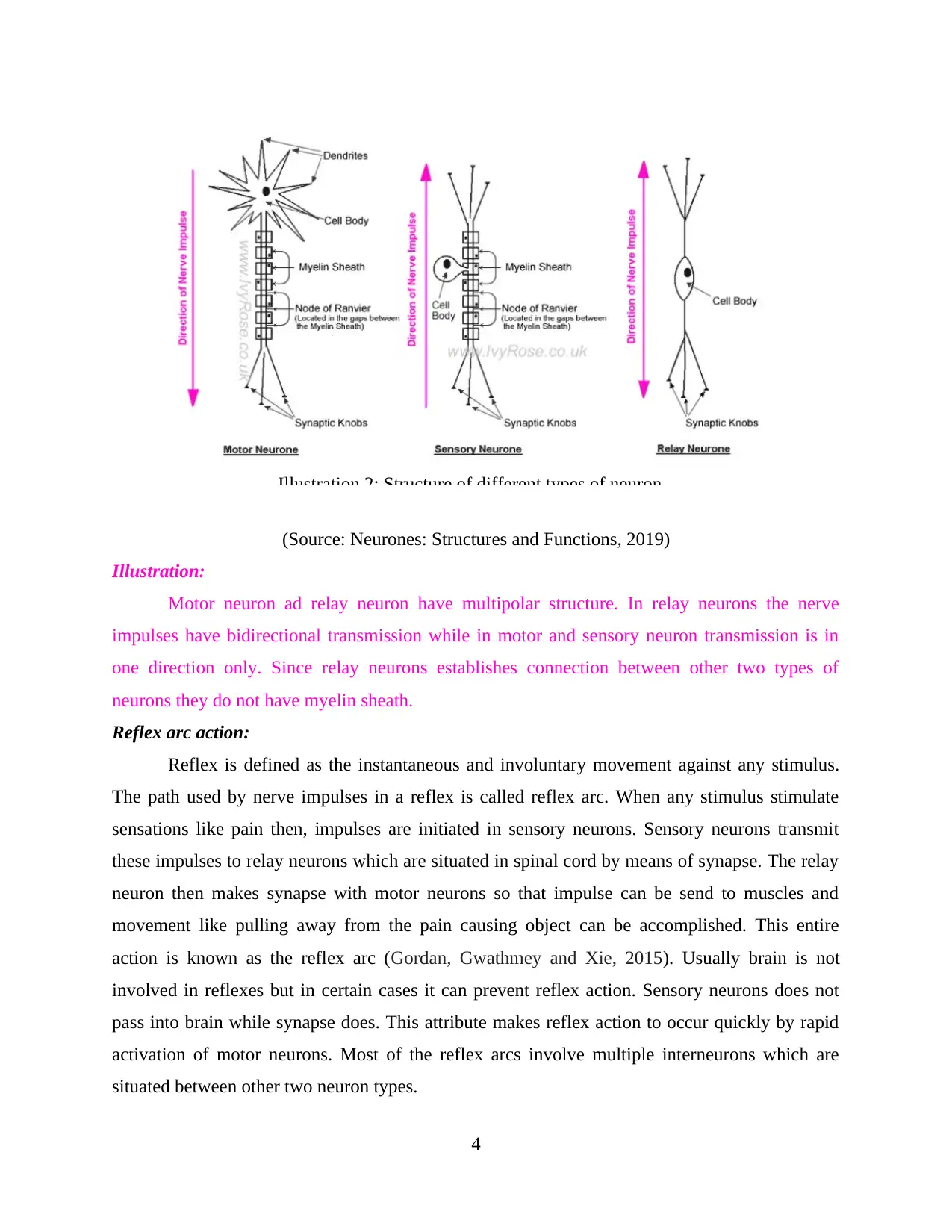
(Source: Neurones: Structures and Functions, 2019)
Illustration:
Motor neuron ad relay neuron have multipolar structure. In relay neurons the nerve
impulses have bidirectional transmission while in motor and sensory neuron transmission is in
one direction only. Since relay neurons establishes connection between other two types of
neurons they do not have myelin sheath.
Reflex arc action:
Reflex is defined as the instantaneous and involuntary movement against any stimulus.
The path used by nerve impulses in a reflex is called reflex arc. When any stimulus stimulate
sensations like pain then, impulses are initiated in sensory neurons. Sensory neurons transmit
these impulses to relay neurons which are situated in spinal cord by means of synapse. The relay
neuron then makes synapse with motor neurons so that impulse can be send to muscles and
movement like pulling away from the pain causing object can be accomplished. This entire
action is known as the reflex arc (Gordan, Gwathmey and Xie, 2015). Usually brain is not
involved in reflexes but in certain cases it can prevent reflex action. Sensory neurons does not
pass into brain while synapse does. This attribute makes reflex action to occur quickly by rapid
activation of motor neurons. Most of the reflex arcs involve multiple interneurons which are
situated between other two neuron types.
4
Illustration 2: Structure of different types of neuron
Illustration:
Motor neuron ad relay neuron have multipolar structure. In relay neurons the nerve
impulses have bidirectional transmission while in motor and sensory neuron transmission is in
one direction only. Since relay neurons establishes connection between other two types of
neurons they do not have myelin sheath.
Reflex arc action:
Reflex is defined as the instantaneous and involuntary movement against any stimulus.
The path used by nerve impulses in a reflex is called reflex arc. When any stimulus stimulate
sensations like pain then, impulses are initiated in sensory neurons. Sensory neurons transmit
these impulses to relay neurons which are situated in spinal cord by means of synapse. The relay
neuron then makes synapse with motor neurons so that impulse can be send to muscles and
movement like pulling away from the pain causing object can be accomplished. This entire
action is known as the reflex arc (Gordan, Gwathmey and Xie, 2015). Usually brain is not
involved in reflexes but in certain cases it can prevent reflex action. Sensory neurons does not
pass into brain while synapse does. This attribute makes reflex action to occur quickly by rapid
activation of motor neurons. Most of the reflex arcs involve multiple interneurons which are
situated between other two neuron types.
4
Illustration 2: Structure of different types of neuron
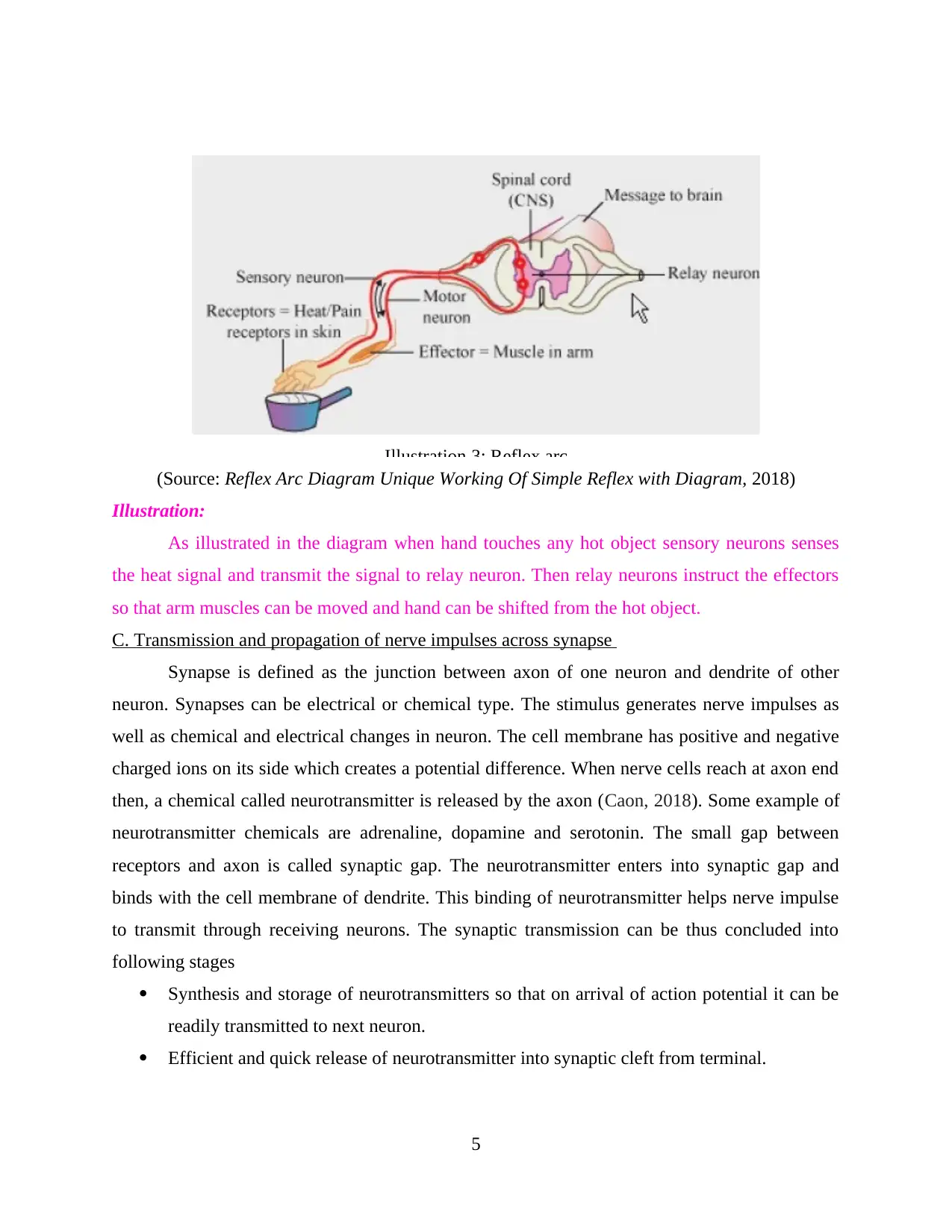
(Source: Reflex Arc Diagram Unique Working Of Simple Reflex with Diagram, 2018)
Illustration:
As illustrated in the diagram when hand touches any hot object sensory neurons senses
the heat signal and transmit the signal to relay neuron. Then relay neurons instruct the effectors
so that arm muscles can be moved and hand can be shifted from the hot object.
C. Transmission and propagation of nerve impulses across synapse
Synapse is defined as the junction between axon of one neuron and dendrite of other
neuron. Synapses can be electrical or chemical type. The stimulus generates nerve impulses as
well as chemical and electrical changes in neuron. The cell membrane has positive and negative
charged ions on its side which creates a potential difference. When nerve cells reach at axon end
then, a chemical called neurotransmitter is released by the axon (Caon, 2018). Some example of
neurotransmitter chemicals are adrenaline, dopamine and serotonin. The small gap between
receptors and axon is called synaptic gap. The neurotransmitter enters into synaptic gap and
binds with the cell membrane of dendrite. This binding of neurotransmitter helps nerve impulse
to transmit through receiving neurons. The synaptic transmission can be thus concluded into
following stages
Synthesis and storage of neurotransmitters so that on arrival of action potential it can be
readily transmitted to next neuron.
Efficient and quick release of neurotransmitter into synaptic cleft from terminal.
5
Illustration 3: Reflex arc
Illustration:
As illustrated in the diagram when hand touches any hot object sensory neurons senses
the heat signal and transmit the signal to relay neuron. Then relay neurons instruct the effectors
so that arm muscles can be moved and hand can be shifted from the hot object.
C. Transmission and propagation of nerve impulses across synapse
Synapse is defined as the junction between axon of one neuron and dendrite of other
neuron. Synapses can be electrical or chemical type. The stimulus generates nerve impulses as
well as chemical and electrical changes in neuron. The cell membrane has positive and negative
charged ions on its side which creates a potential difference. When nerve cells reach at axon end
then, a chemical called neurotransmitter is released by the axon (Caon, 2018). Some example of
neurotransmitter chemicals are adrenaline, dopamine and serotonin. The small gap between
receptors and axon is called synaptic gap. The neurotransmitter enters into synaptic gap and
binds with the cell membrane of dendrite. This binding of neurotransmitter helps nerve impulse
to transmit through receiving neurons. The synaptic transmission can be thus concluded into
following stages
Synthesis and storage of neurotransmitters so that on arrival of action potential it can be
readily transmitted to next neuron.
Efficient and quick release of neurotransmitter into synaptic cleft from terminal.
5
Illustration 3: Reflex arc
Paraphrase This Document
Need a fresh take? Get an instant paraphrase of this document with our AI Paraphraser

Recognition of neurotransmitter by selective receptors of postsynaptic cells for initiating
or blocking the signals from transmission.
Inactivation of neurotransmitter so that receptor sites can be freed for the next arriving
potential actions (Lousado and et.al., 2017).
The neurotransmitters are very specific and each type of the chemical transmits only a
particular type of information. Thus, it is possible that certain neurotransmitters may have high
concentration in specific brain regions. The action of these chemicals also depends upon the type
of targeted cell and co-released neurotransmitters. Thus, along with the synaptic transmission of
the nerve impulses these chemicals plays an integral role in normal functioning of the
brain(Waguespack and Chemaitilly, 2018). Thus, a minor imbalance in the concentration of
these chemicals can lead to severe clinical implications.
The imbalance in the neurotransmitters can be a result of genetic factors, drugs, ageing or
other biological dysfunctions. These imbalances cause diseases such as Parkinson's disease,
Alzheimer's and Schizophrenia. For instance in Parkinson's disease nerve cells which produces
dopamine neurotransmitter begin to die off. The loss of dopamine by 80% leads to the symptoms
such as stiffness, tremor, balancing and other issues (Milovanović and et.al., 2016). When
dopamine receptors are not stimulated properly then, nerve impulses are not transmitted
effectively from one cell to other. In order to compensate the shortage of dopamine in people
suffering from Parkinson's disease another type of neurotransmitter called glutamate is secreted
in excess.
6
or blocking the signals from transmission.
Inactivation of neurotransmitter so that receptor sites can be freed for the next arriving
potential actions (Lousado and et.al., 2017).
The neurotransmitters are very specific and each type of the chemical transmits only a
particular type of information. Thus, it is possible that certain neurotransmitters may have high
concentration in specific brain regions. The action of these chemicals also depends upon the type
of targeted cell and co-released neurotransmitters. Thus, along with the synaptic transmission of
the nerve impulses these chemicals plays an integral role in normal functioning of the
brain(Waguespack and Chemaitilly, 2018). Thus, a minor imbalance in the concentration of
these chemicals can lead to severe clinical implications.
The imbalance in the neurotransmitters can be a result of genetic factors, drugs, ageing or
other biological dysfunctions. These imbalances cause diseases such as Parkinson's disease,
Alzheimer's and Schizophrenia. For instance in Parkinson's disease nerve cells which produces
dopamine neurotransmitter begin to die off. The loss of dopamine by 80% leads to the symptoms
such as stiffness, tremor, balancing and other issues (Milovanović and et.al., 2016). When
dopamine receptors are not stimulated properly then, nerve impulses are not transmitted
effectively from one cell to other. In order to compensate the shortage of dopamine in people
suffering from Parkinson's disease another type of neurotransmitter called glutamate is secreted
in excess.
6

(Source: Nervous system, 2019)
Illustration:
For the synaptic transmission as soon as action potential reach axon terminal calcium
channels are opened. It causes the neurotransmitter release by vesicles so that it can transmit
through synapse. When neurotransmitter binds with the neuroreceptors then signals are triggered
in post synaptic neuron for the transmission purpose.
TASK 2
A. Endocrine system and principle secretions of glands
Endocrine system is made up of hormone secreting glands. The endocrine glands are
responsible for the regulation of hormones into blood stream so that growth, metabolism,
reproduction and functioning of organs can be assured. The major glands and their principles
hormones are as follows:
Pituitary gland: It is located beneath hypothalamus and produces hormones which controls the
functionality of other endocrine glands. The major hormones produced by this gland are growth
hormone (promotes growth), Thyroid stimulating hormone (stimulate thyroid gland),
Adrenocorticotropin hormone (ACTH which stimulate adrenal gland), LH and FSH hormone
(controls sexual function and production of sex steroids).
Adrenal gland: The adrenal gland is present on top of kidney. It produces hormones such as
corticosteroids (regulate metabolism, water and salt balance) and catecholamines hormone like
7
Illustration 4: Synaptic transmission
Illustration:
For the synaptic transmission as soon as action potential reach axon terminal calcium
channels are opened. It causes the neurotransmitter release by vesicles so that it can transmit
through synapse. When neurotransmitter binds with the neuroreceptors then signals are triggered
in post synaptic neuron for the transmission purpose.
TASK 2
A. Endocrine system and principle secretions of glands
Endocrine system is made up of hormone secreting glands. The endocrine glands are
responsible for the regulation of hormones into blood stream so that growth, metabolism,
reproduction and functioning of organs can be assured. The major glands and their principles
hormones are as follows:
Pituitary gland: It is located beneath hypothalamus and produces hormones which controls the
functionality of other endocrine glands. The major hormones produced by this gland are growth
hormone (promotes growth), Thyroid stimulating hormone (stimulate thyroid gland),
Adrenocorticotropin hormone (ACTH which stimulate adrenal gland), LH and FSH hormone
(controls sexual function and production of sex steroids).
Adrenal gland: The adrenal gland is present on top of kidney. It produces hormones such as
corticosteroids (regulate metabolism, water and salt balance) and catecholamines hormone like
7
Illustration 4: Synaptic transmission
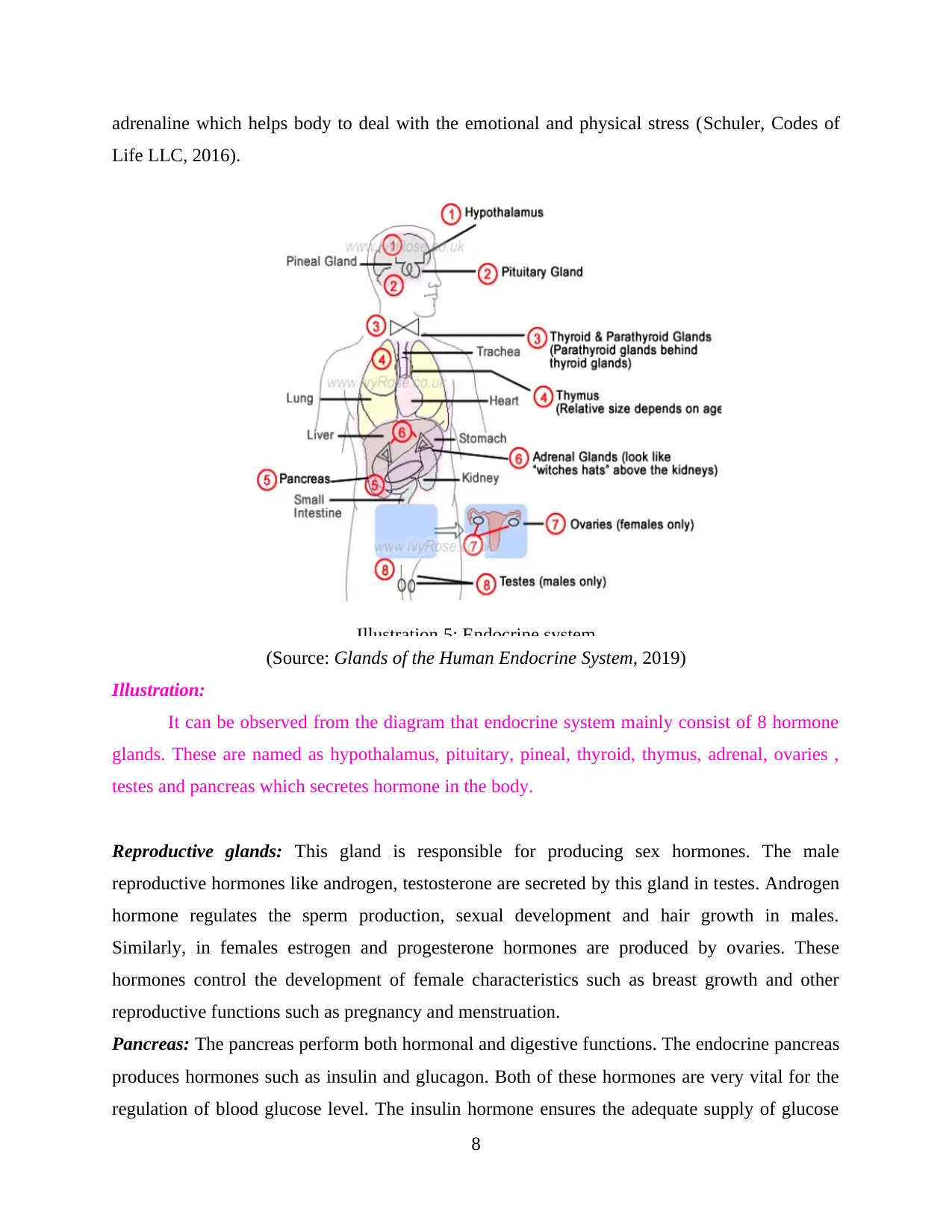
adrenaline which helps body to deal with the emotional and physical stress (Schuler, Codes of
Life LLC, 2016).
(Source: Glands of the Human Endocrine System, 2019)
Illustration:
It can be observed from the diagram that endocrine system mainly consist of 8 hormone
glands. These are named as hypothalamus, pituitary, pineal, thyroid, thymus, adrenal, ovaries ,
testes and pancreas which secretes hormone in the body.
Reproductive glands: This gland is responsible for producing sex hormones. The male
reproductive hormones like androgen, testosterone are secreted by this gland in testes. Androgen
hormone regulates the sperm production, sexual development and hair growth in males.
Similarly, in females estrogen and progesterone hormones are produced by ovaries. These
hormones control the development of female characteristics such as breast growth and other
reproductive functions such as pregnancy and menstruation.
Pancreas: The pancreas perform both hormonal and digestive functions. The endocrine pancreas
produces hormones such as insulin and glucagon. Both of these hormones are very vital for the
regulation of blood glucose level. The insulin hormone ensures the adequate supply of glucose
8
Illustration 5: Endocrine system
Life LLC, 2016).
(Source: Glands of the Human Endocrine System, 2019)
Illustration:
It can be observed from the diagram that endocrine system mainly consist of 8 hormone
glands. These are named as hypothalamus, pituitary, pineal, thyroid, thymus, adrenal, ovaries ,
testes and pancreas which secretes hormone in the body.
Reproductive glands: This gland is responsible for producing sex hormones. The male
reproductive hormones like androgen, testosterone are secreted by this gland in testes. Androgen
hormone regulates the sperm production, sexual development and hair growth in males.
Similarly, in females estrogen and progesterone hormones are produced by ovaries. These
hormones control the development of female characteristics such as breast growth and other
reproductive functions such as pregnancy and menstruation.
Pancreas: The pancreas perform both hormonal and digestive functions. The endocrine pancreas
produces hormones such as insulin and glucagon. Both of these hormones are very vital for the
regulation of blood glucose level. The insulin hormone ensures the adequate supply of glucose
8
Illustration 5: Endocrine system
Secure Best Marks with AI Grader
Need help grading? Try our AI Grader for instant feedback on your assignments.
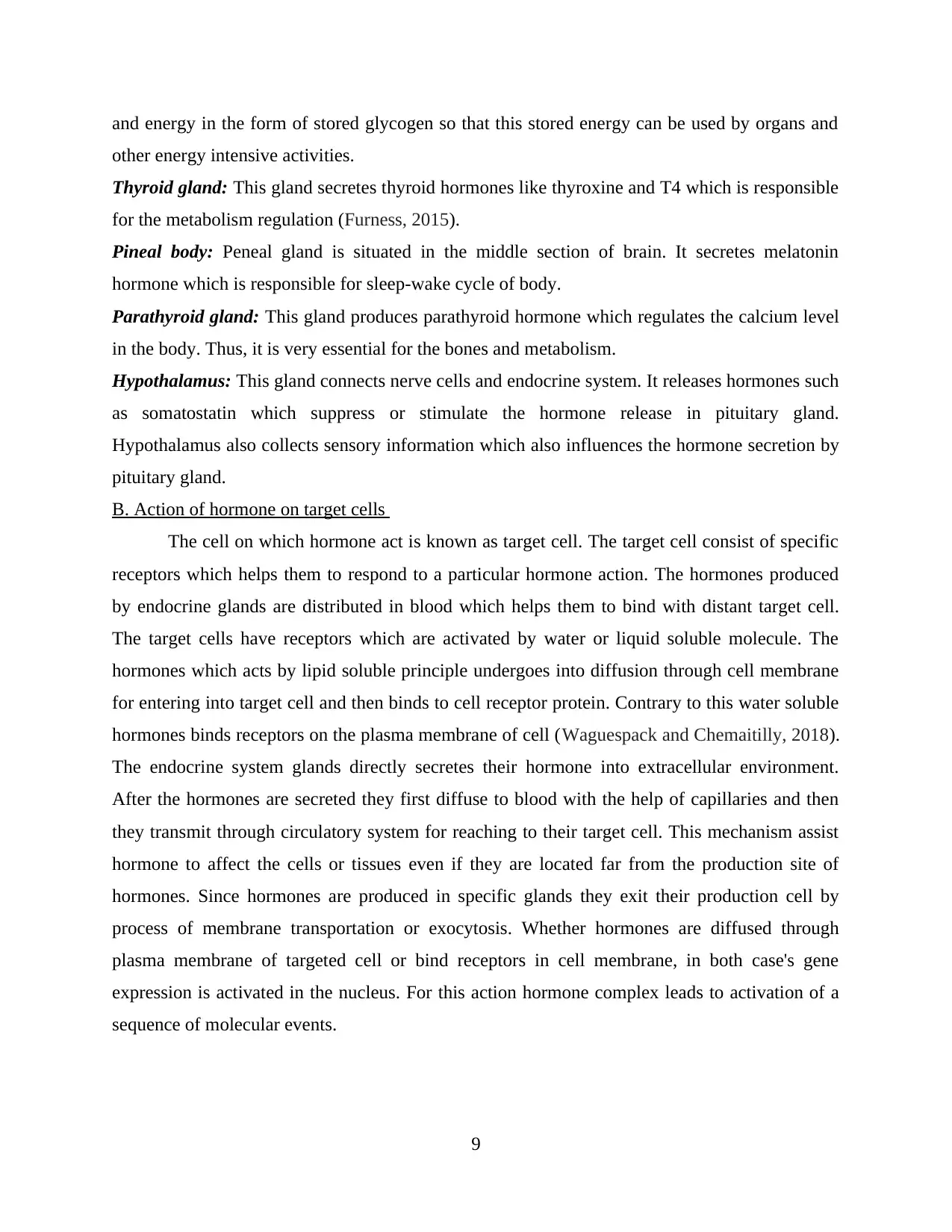
and energy in the form of stored glycogen so that this stored energy can be used by organs and
other energy intensive activities.
Thyroid gland: This gland secretes thyroid hormones like thyroxine and T4 which is responsible
for the metabolism regulation (Furness, 2015).
Pineal body: Peneal gland is situated in the middle section of brain. It secretes melatonin
hormone which is responsible for sleep-wake cycle of body.
Parathyroid gland: This gland produces parathyroid hormone which regulates the calcium level
in the body. Thus, it is very essential for the bones and metabolism.
Hypothalamus: This gland connects nerve cells and endocrine system. It releases hormones such
as somatostatin which suppress or stimulate the hormone release in pituitary gland.
Hypothalamus also collects sensory information which also influences the hormone secretion by
pituitary gland.
B. Action of hormone on target cells
The cell on which hormone act is known as target cell. The target cell consist of specific
receptors which helps them to respond to a particular hormone action. The hormones produced
by endocrine glands are distributed in blood which helps them to bind with distant target cell.
The target cells have receptors which are activated by water or liquid soluble molecule. The
hormones which acts by lipid soluble principle undergoes into diffusion through cell membrane
for entering into target cell and then binds to cell receptor protein. Contrary to this water soluble
hormones binds receptors on the plasma membrane of cell (Waguespack and Chemaitilly, 2018).
The endocrine system glands directly secretes their hormone into extracellular environment.
After the hormones are secreted they first diffuse to blood with the help of capillaries and then
they transmit through circulatory system for reaching to their target cell. This mechanism assist
hormone to affect the cells or tissues even if they are located far from the production site of
hormones. Since hormones are produced in specific glands they exit their production cell by
process of membrane transportation or exocytosis. Whether hormones are diffused through
plasma membrane of targeted cell or bind receptors in cell membrane, in both case's gene
expression is activated in the nucleus. For this action hormone complex leads to activation of a
sequence of molecular events.
9
other energy intensive activities.
Thyroid gland: This gland secretes thyroid hormones like thyroxine and T4 which is responsible
for the metabolism regulation (Furness, 2015).
Pineal body: Peneal gland is situated in the middle section of brain. It secretes melatonin
hormone which is responsible for sleep-wake cycle of body.
Parathyroid gland: This gland produces parathyroid hormone which regulates the calcium level
in the body. Thus, it is very essential for the bones and metabolism.
Hypothalamus: This gland connects nerve cells and endocrine system. It releases hormones such
as somatostatin which suppress or stimulate the hormone release in pituitary gland.
Hypothalamus also collects sensory information which also influences the hormone secretion by
pituitary gland.
B. Action of hormone on target cells
The cell on which hormone act is known as target cell. The target cell consist of specific
receptors which helps them to respond to a particular hormone action. The hormones produced
by endocrine glands are distributed in blood which helps them to bind with distant target cell.
The target cells have receptors which are activated by water or liquid soluble molecule. The
hormones which acts by lipid soluble principle undergoes into diffusion through cell membrane
for entering into target cell and then binds to cell receptor protein. Contrary to this water soluble
hormones binds receptors on the plasma membrane of cell (Waguespack and Chemaitilly, 2018).
The endocrine system glands directly secretes their hormone into extracellular environment.
After the hormones are secreted they first diffuse to blood with the help of capillaries and then
they transmit through circulatory system for reaching to their target cell. This mechanism assist
hormone to affect the cells or tissues even if they are located far from the production site of
hormones. Since hormones are produced in specific glands they exit their production cell by
process of membrane transportation or exocytosis. Whether hormones are diffused through
plasma membrane of targeted cell or bind receptors in cell membrane, in both case's gene
expression is activated in the nucleus. For this action hormone complex leads to activation of a
sequence of molecular events.
9

For instance intracellular DNA binding protein is receptor for thyroxine (Caon, 2018).
The thyroxine hormone enters cell through membrane and within nucleus it binds with the
receptor. On interaction with the receptor a complex is formed modulates the gene expressions.
C. Positive and negative feedback systems
Hormone and fluid regulation is an important aspect of homeostasis process. Feedback
mechanisms aims to regularly monitor and control the various aspects of body so that
homeostasis can be achieved. Feedback systems are of two types: positive and negative:
Positive feedback:
As compare to negative feedback, positive feedback is very limited. This type of
feedback aims to control the self-perpetuating events. Such types of events are usually
uncontrollable and does not have any need of continuous adjustments. Contrary to the negative
type this type of feedback promotes the original stimulus and enhances the deviation from ideal
value. The common example for positive feedback is oxytocin hormone in which changes are not
reversed instead they are amplified. During labor oxytocin hormone is released from posterior
pituitary gland. The hormone stimulates the contraction of muscles so that baby can be pushed
through birth canal (Milovanović and et.al., 2016). The oxytocin release causes stronger
contractions. These contractions are intensified and increased until baby is outside birth canal.
The oxytocin production and labor contractions are terminated only when pressure receptor
stimulus are ends. During entire pregnancy the receptors cells which responds to oxytocin. Thus,
the positive feedback systems tends to comprise events which discontinues or break the feedback
loop when appropriate.
Negative feedback:
This is the most common feedback mechanism which regulates variety of hormones of
endocrine gland. In this type of mechanism response and original stimulus are opposite or
inversely proportional to each other. One of the most common example of negative feedback is
the calcium regulation in the body. The parathyroid hormone which is produced in parathyroid
gland controls the secretion of calcium hormone (Pannese, 2015). The elevation and decline in
the calcium are detected by parathyroid hormone. This hormone stimulated the release of
calcium from bones and thus causes an increase in blood. However, when the amount or
concentration of calcium increases beyond desired levels then the production of parathyroid
hormone is reduced by parathyroid gland. As response has opposite reaction to that of stimulus it
10
The thyroxine hormone enters cell through membrane and within nucleus it binds with the
receptor. On interaction with the receptor a complex is formed modulates the gene expressions.
C. Positive and negative feedback systems
Hormone and fluid regulation is an important aspect of homeostasis process. Feedback
mechanisms aims to regularly monitor and control the various aspects of body so that
homeostasis can be achieved. Feedback systems are of two types: positive and negative:
Positive feedback:
As compare to negative feedback, positive feedback is very limited. This type of
feedback aims to control the self-perpetuating events. Such types of events are usually
uncontrollable and does not have any need of continuous adjustments. Contrary to the negative
type this type of feedback promotes the original stimulus and enhances the deviation from ideal
value. The common example for positive feedback is oxytocin hormone in which changes are not
reversed instead they are amplified. During labor oxytocin hormone is released from posterior
pituitary gland. The hormone stimulates the contraction of muscles so that baby can be pushed
through birth canal (Milovanović and et.al., 2016). The oxytocin release causes stronger
contractions. These contractions are intensified and increased until baby is outside birth canal.
The oxytocin production and labor contractions are terminated only when pressure receptor
stimulus are ends. During entire pregnancy the receptors cells which responds to oxytocin. Thus,
the positive feedback systems tends to comprise events which discontinues or break the feedback
loop when appropriate.
Negative feedback:
This is the most common feedback mechanism which regulates variety of hormones of
endocrine gland. In this type of mechanism response and original stimulus are opposite or
inversely proportional to each other. One of the most common example of negative feedback is
the calcium regulation in the body. The parathyroid hormone which is produced in parathyroid
gland controls the secretion of calcium hormone (Pannese, 2015). The elevation and decline in
the calcium are detected by parathyroid hormone. This hormone stimulated the release of
calcium from bones and thus causes an increase in blood. However, when the amount or
concentration of calcium increases beyond desired levels then the production of parathyroid
hormone is reduced by parathyroid gland. As response has opposite reaction to that of stimulus it
10

can be considered as the negative feedback. Thus, it can be concluded that negative feedback
helps body to bring the conditions as earlier or within normal range.
TASK 3
Glucose regulation
Glucose is mono-saccharide sugar which breaks down and produces ATP energy so that
biochemical reactions can take place in the body. The liver cells absorb and converts most of the
glucose into glycogen so that when body glucose level falls it can be used. Glucose regulation is
one of the essential process for homeostasis as for proper functioning of nerve cells adequate
levels of glucose is vital.
Glucose regulation and response to hyperglycaemia and hypoglycaemia
After food intake, the increased glucose level in the body is buffered by storage of
glucose in liver. The endocrine glands present in pancreas secretes glucose regulating hormones
such as glucagon, insulin and somatostatin (Peiris and Keating, 2018). The increase in glucose
levels in blood (hyperglycaemia) is detected by pancreatic islets so that more insulin can be
released by pancreatic beta cells into blood. Insulin absorbs glucose from the cells. When insulin
binds with the receptors located on cell membrane then, glucose transporters are increased and
due to enhanced transportation of glucose into cells, blood glucose decreases.
Similarly, after few hours of eating blood glucose level decreases along with insulin
levels. In response to this alpha cells of pancreas releases glucagon hormone. Glucagon hormone
encourages the processes which spare the glucose utilisation (How insulin and glucagon regulate
blood sugar, 2019). It increases the glucose levels in blood. The glycogen which is stored in the
liver is converted into glucose by Glucagon so that it can be released into blood. In addition, this
hormone also promote the synthesis of new glucose with the help of metabolites and lactic acid.
Glucose regulation is considered as the negative feedback based homeostatic control in which
deviation from the normal glucose values triggers the corrective response which in turn is
terminated by returning of blood glucose to normal levels.
11
helps body to bring the conditions as earlier or within normal range.
TASK 3
Glucose regulation
Glucose is mono-saccharide sugar which breaks down and produces ATP energy so that
biochemical reactions can take place in the body. The liver cells absorb and converts most of the
glucose into glycogen so that when body glucose level falls it can be used. Glucose regulation is
one of the essential process for homeostasis as for proper functioning of nerve cells adequate
levels of glucose is vital.
Glucose regulation and response to hyperglycaemia and hypoglycaemia
After food intake, the increased glucose level in the body is buffered by storage of
glucose in liver. The endocrine glands present in pancreas secretes glucose regulating hormones
such as glucagon, insulin and somatostatin (Peiris and Keating, 2018). The increase in glucose
levels in blood (hyperglycaemia) is detected by pancreatic islets so that more insulin can be
released by pancreatic beta cells into blood. Insulin absorbs glucose from the cells. When insulin
binds with the receptors located on cell membrane then, glucose transporters are increased and
due to enhanced transportation of glucose into cells, blood glucose decreases.
Similarly, after few hours of eating blood glucose level decreases along with insulin
levels. In response to this alpha cells of pancreas releases glucagon hormone. Glucagon hormone
encourages the processes which spare the glucose utilisation (How insulin and glucagon regulate
blood sugar, 2019). It increases the glucose levels in blood. The glycogen which is stored in the
liver is converted into glucose by Glucagon so that it can be released into blood. In addition, this
hormone also promote the synthesis of new glucose with the help of metabolites and lactic acid.
Glucose regulation is considered as the negative feedback based homeostatic control in which
deviation from the normal glucose values triggers the corrective response which in turn is
terminated by returning of blood glucose to normal levels.
11
Paraphrase This Document
Need a fresh take? Get an instant paraphrase of this document with our AI Paraphraser
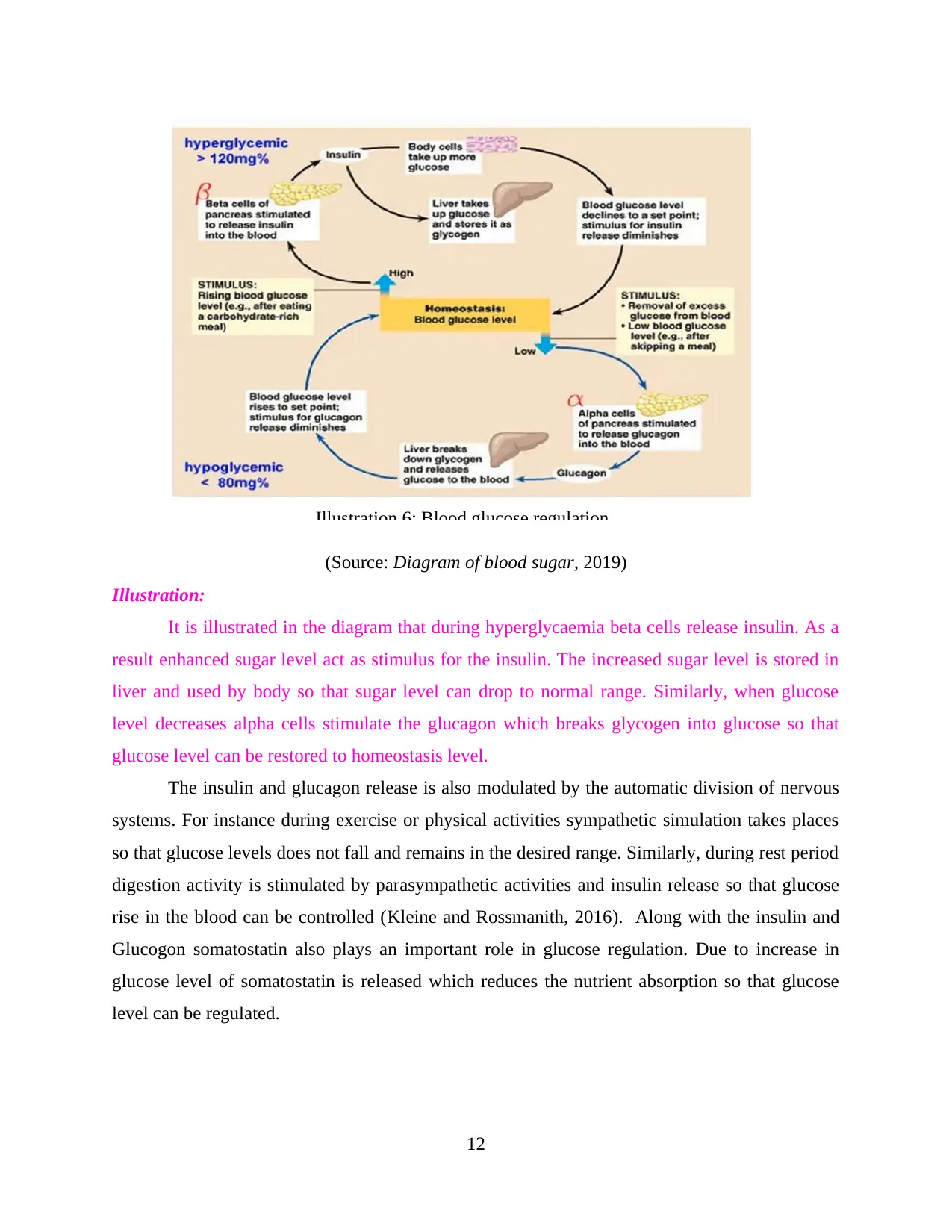
(Source: Diagram of blood sugar, 2019)
Illustration:
It is illustrated in the diagram that during hyperglycaemia beta cells release insulin. As a
result enhanced sugar level act as stimulus for the insulin. The increased sugar level is stored in
liver and used by body so that sugar level can drop to normal range. Similarly, when glucose
level decreases alpha cells stimulate the glucagon which breaks glycogen into glucose so that
glucose level can be restored to homeostasis level.
The insulin and glucagon release is also modulated by the automatic division of nervous
systems. For instance during exercise or physical activities sympathetic simulation takes places
so that glucose levels does not fall and remains in the desired range. Similarly, during rest period
digestion activity is stimulated by parasympathetic activities and insulin release so that glucose
rise in the blood can be controlled (Kleine and Rossmanith, 2016). Along with the insulin and
Glucogon somatostatin also plays an important role in glucose regulation. Due to increase in
glucose level of somatostatin is released which reduces the nutrient absorption so that glucose
level can be regulated.
12
Illustration 6: Blood glucose regulation
Illustration:
It is illustrated in the diagram that during hyperglycaemia beta cells release insulin. As a
result enhanced sugar level act as stimulus for the insulin. The increased sugar level is stored in
liver and used by body so that sugar level can drop to normal range. Similarly, when glucose
level decreases alpha cells stimulate the glucagon which breaks glycogen into glucose so that
glucose level can be restored to homeostasis level.
The insulin and glucagon release is also modulated by the automatic division of nervous
systems. For instance during exercise or physical activities sympathetic simulation takes places
so that glucose levels does not fall and remains in the desired range. Similarly, during rest period
digestion activity is stimulated by parasympathetic activities and insulin release so that glucose
rise in the blood can be controlled (Kleine and Rossmanith, 2016). Along with the insulin and
Glucogon somatostatin also plays an important role in glucose regulation. Due to increase in
glucose level of somatostatin is released which reduces the nutrient absorption so that glucose
level can be regulated.
12
Illustration 6: Blood glucose regulation

CONCLUSION
From the above discussion it can be concluded that nervous system and endocrine
systems plays very important role in homeostasis process. The study has also discussed the
mechanism of glucose regulation so that role of endocrine systems can be understood more
effectively.
13
From the above discussion it can be concluded that nervous system and endocrine
systems plays very important role in homeostasis process. The study has also discussed the
mechanism of glucose regulation so that role of endocrine systems can be understood more
effectively.
13
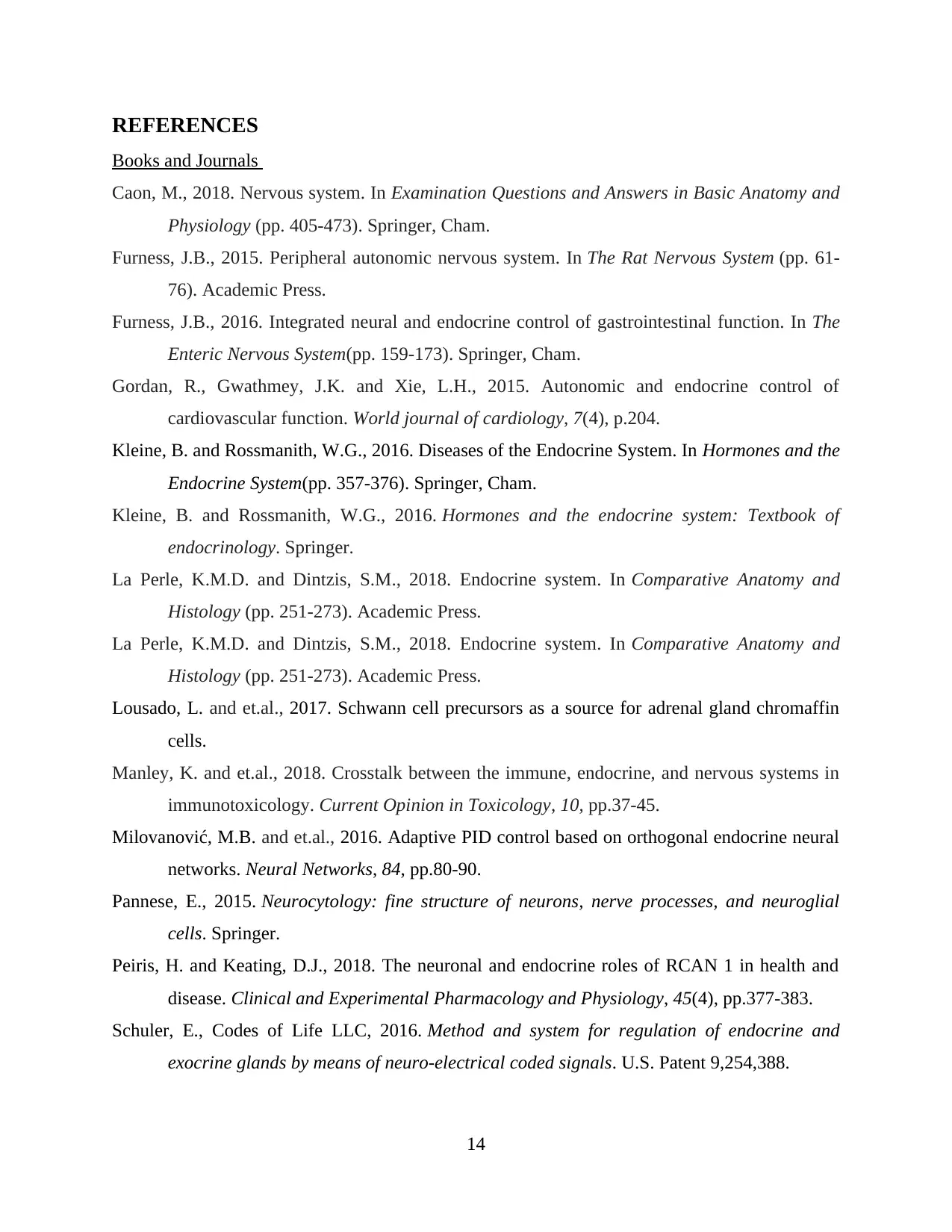
REFERENCES
Books and Journals
Caon, M., 2018. Nervous system. In Examination Questions and Answers in Basic Anatomy and
Physiology (pp. 405-473). Springer, Cham.
Furness, J.B., 2015. Peripheral autonomic nervous system. In The Rat Nervous System (pp. 61-
76). Academic Press.
Furness, J.B., 2016. Integrated neural and endocrine control of gastrointestinal function. In The
Enteric Nervous System(pp. 159-173). Springer, Cham.
Gordan, R., Gwathmey, J.K. and Xie, L.H., 2015. Autonomic and endocrine control of
cardiovascular function. World journal of cardiology, 7(4), p.204.
Kleine, B. and Rossmanith, W.G., 2016. Diseases of the Endocrine System. In Hormones and the
Endocrine System(pp. 357-376). Springer, Cham.
Kleine, B. and Rossmanith, W.G., 2016. Hormones and the endocrine system: Textbook of
endocrinology. Springer.
La Perle, K.M.D. and Dintzis, S.M., 2018. Endocrine system. In Comparative Anatomy and
Histology (pp. 251-273). Academic Press.
La Perle, K.M.D. and Dintzis, S.M., 2018. Endocrine system. In Comparative Anatomy and
Histology (pp. 251-273). Academic Press.
Lousado, L. and et.al., 2017. Schwann cell precursors as a source for adrenal gland chromaffin
cells.
Manley, K. and et.al., 2018. Crosstalk between the immune, endocrine, and nervous systems in
immunotoxicology. Current Opinion in Toxicology, 10, pp.37-45.
Milovanović, M.B. and et.al., 2016. Adaptive PID control based on orthogonal endocrine neural
networks. Neural Networks, 84, pp.80-90.
Pannese, E., 2015. Neurocytology: fine structure of neurons, nerve processes, and neuroglial
cells. Springer.
Peiris, H. and Keating, D.J., 2018. The neuronal and endocrine roles of RCAN 1 in health and
disease. Clinical and Experimental Pharmacology and Physiology, 45(4), pp.377-383.
Schuler, E., Codes of Life LLC, 2016. Method and system for regulation of endocrine and
exocrine glands by means of neuro-electrical coded signals. U.S. Patent 9,254,388.
14
Books and Journals
Caon, M., 2018. Nervous system. In Examination Questions and Answers in Basic Anatomy and
Physiology (pp. 405-473). Springer, Cham.
Furness, J.B., 2015. Peripheral autonomic nervous system. In The Rat Nervous System (pp. 61-
76). Academic Press.
Furness, J.B., 2016. Integrated neural and endocrine control of gastrointestinal function. In The
Enteric Nervous System(pp. 159-173). Springer, Cham.
Gordan, R., Gwathmey, J.K. and Xie, L.H., 2015. Autonomic and endocrine control of
cardiovascular function. World journal of cardiology, 7(4), p.204.
Kleine, B. and Rossmanith, W.G., 2016. Diseases of the Endocrine System. In Hormones and the
Endocrine System(pp. 357-376). Springer, Cham.
Kleine, B. and Rossmanith, W.G., 2016. Hormones and the endocrine system: Textbook of
endocrinology. Springer.
La Perle, K.M.D. and Dintzis, S.M., 2018. Endocrine system. In Comparative Anatomy and
Histology (pp. 251-273). Academic Press.
La Perle, K.M.D. and Dintzis, S.M., 2018. Endocrine system. In Comparative Anatomy and
Histology (pp. 251-273). Academic Press.
Lousado, L. and et.al., 2017. Schwann cell precursors as a source for adrenal gland chromaffin
cells.
Manley, K. and et.al., 2018. Crosstalk between the immune, endocrine, and nervous systems in
immunotoxicology. Current Opinion in Toxicology, 10, pp.37-45.
Milovanović, M.B. and et.al., 2016. Adaptive PID control based on orthogonal endocrine neural
networks. Neural Networks, 84, pp.80-90.
Pannese, E., 2015. Neurocytology: fine structure of neurons, nerve processes, and neuroglial
cells. Springer.
Peiris, H. and Keating, D.J., 2018. The neuronal and endocrine roles of RCAN 1 in health and
disease. Clinical and Experimental Pharmacology and Physiology, 45(4), pp.377-383.
Schuler, E., Codes of Life LLC, 2016. Method and system for regulation of endocrine and
exocrine glands by means of neuro-electrical coded signals. U.S. Patent 9,254,388.
14
Secure Best Marks with AI Grader
Need help grading? Try our AI Grader for instant feedback on your assignments.
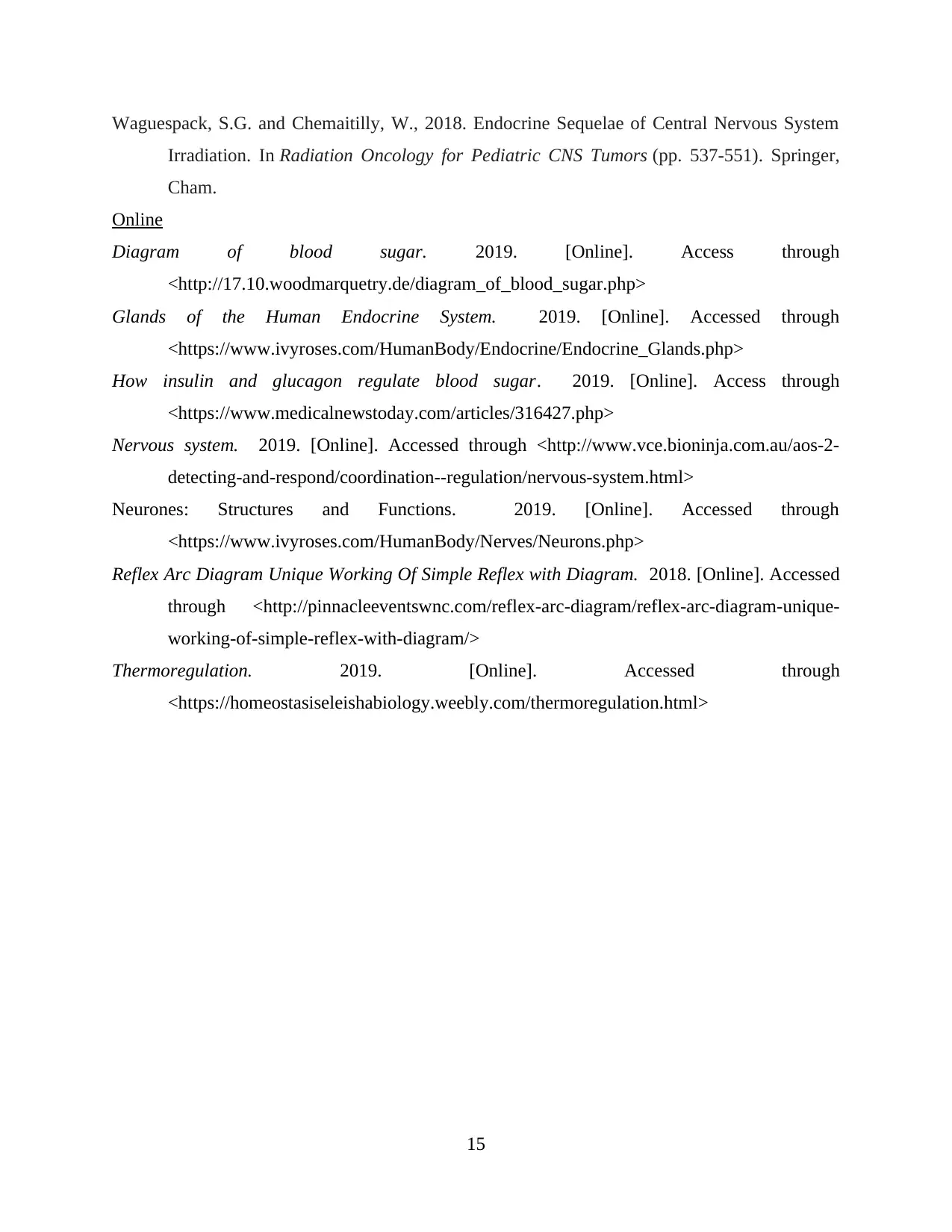
Waguespack, S.G. and Chemaitilly, W., 2018. Endocrine Sequelae of Central Nervous System
Irradiation. In Radiation Oncology for Pediatric CNS Tumors (pp. 537-551). Springer,
Cham.
Online
Diagram of blood sugar. 2019. [Online]. Access through
<http://17.10.woodmarquetry.de/diagram_of_blood_sugar.php>
Glands of the Human Endocrine System. 2019. [Online]. Accessed through
<https://www.ivyroses.com/HumanBody/Endocrine/Endocrine_Glands.php>
How insulin and glucagon regulate blood sugar. 2019. [Online]. Access through
<https://www.medicalnewstoday.com/articles/316427.php>
Nervous system. 2019. [Online]. Accessed through <http://www.vce.bioninja.com.au/aos-2-
detecting-and-respond/coordination--regulation/nervous-system.html>
Neurones: Structures and Functions. 2019. [Online]. Accessed through
<https://www.ivyroses.com/HumanBody/Nerves/Neurons.php>
Reflex Arc Diagram Unique Working Of Simple Reflex with Diagram. 2018. [Online]. Accessed
through <http://pinnacleeventswnc.com/reflex-arc-diagram/reflex-arc-diagram-unique-
working-of-simple-reflex-with-diagram/>
Thermoregulation. 2019. [Online]. Accessed through
<https://homeostasiseleishabiology.weebly.com/thermoregulation.html>
15
Irradiation. In Radiation Oncology for Pediatric CNS Tumors (pp. 537-551). Springer,
Cham.
Online
Diagram of blood sugar. 2019. [Online]. Access through
<http://17.10.woodmarquetry.de/diagram_of_blood_sugar.php>
Glands of the Human Endocrine System. 2019. [Online]. Accessed through
<https://www.ivyroses.com/HumanBody/Endocrine/Endocrine_Glands.php>
How insulin and glucagon regulate blood sugar. 2019. [Online]. Access through
<https://www.medicalnewstoday.com/articles/316427.php>
Nervous system. 2019. [Online]. Accessed through <http://www.vce.bioninja.com.au/aos-2-
detecting-and-respond/coordination--regulation/nervous-system.html>
Neurones: Structures and Functions. 2019. [Online]. Accessed through
<https://www.ivyroses.com/HumanBody/Nerves/Neurons.php>
Reflex Arc Diagram Unique Working Of Simple Reflex with Diagram. 2018. [Online]. Accessed
through <http://pinnacleeventswnc.com/reflex-arc-diagram/reflex-arc-diagram-unique-
working-of-simple-reflex-with-diagram/>
Thermoregulation. 2019. [Online]. Accessed through
<https://homeostasiseleishabiology.weebly.com/thermoregulation.html>
15

16

17
Paraphrase This Document
Need a fresh take? Get an instant paraphrase of this document with our AI Paraphraser

18

19
1 out of 21
Related Documents
Your All-in-One AI-Powered Toolkit for Academic Success.
+13062052269
info@desklib.com
Available 24*7 on WhatsApp / Email
![[object Object]](/_next/static/media/star-bottom.7253800d.svg)
Unlock your academic potential
© 2024 | Zucol Services PVT LTD | All rights reserved.





